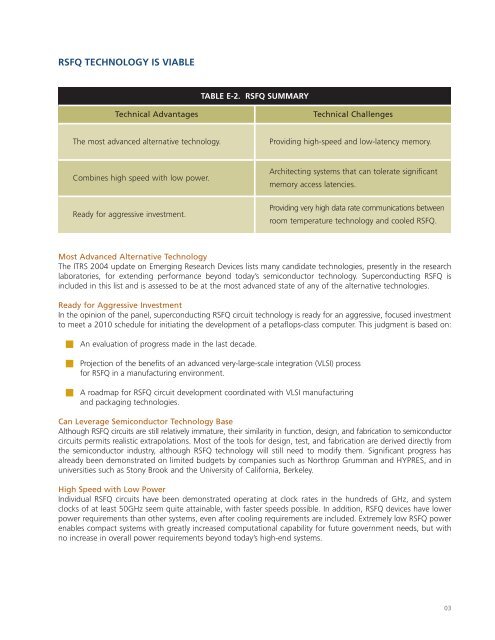Superconducting Technology Assessment - nitrd
Superconducting Technology Assessment - nitrd
Superconducting Technology Assessment - nitrd
Create successful ePaper yourself
Turn your PDF publications into a flip-book with our unique Google optimized e-Paper software.
RSFQ TECHNOLOGY IS VIABLE<br />
Technical Advantages<br />
The most advanced alternative technology.<br />
Combines high speed with low power.<br />
Ready for aggressive investment.<br />
TABLE E-2. RSFQ SUMMARY<br />
Most Advanced Alternative <strong>Technology</strong><br />
The ITRS 2004 update on Emerging Research Devices lists many candidate technologies, presently in the research<br />
laboratories, for extending performance beyond today’s semiconductor technology. <strong>Superconducting</strong> RSFQ is<br />
included in this list and is assessed to be at the most advanced state of any of the alternative technologies.<br />
Ready for Aggressive Investment<br />
In the opinion of the panel, superconducting RSFQ circuit technology is ready for an aggressive, focused investment<br />
to meet a 2010 schedule for initiating the development of a petaflops-class computer. This judgment is based on:<br />
■ An evaluation of progress made in the last decade.<br />
Technical Challenges<br />
Providing high-speed and low-latency memory.<br />
Architecting systems that can tolerate significant<br />
memory access latencies.<br />
■ Projection of the benefits of an advanced very-large-scale integration (VLSI) process<br />
for RSFQ in a manufacturing environment.<br />
■ A roadmap for RSFQ circuit development coordinated with VLSI manufacturing<br />
and packaging technologies.<br />
Providing very high data rate communications between<br />
room temperature technology and cooled RSFQ.<br />
Can Leverage Semiconductor <strong>Technology</strong> Base<br />
Although RSFQ circuits are still relatively immature, their similarity in function, design, and fabrication to semiconductor<br />
circuits permits realistic extrapolations. Most of the tools for design, test, and fabrication are derived directly from<br />
the semiconductor industry, although RSFQ technology will still need to modify them. Significant progress has<br />
already been demonstrated on limited budgets by companies such as Northrop Grumman and HYPRES, and in<br />
universities such as Stony Brook and the University of California, Berkeley.<br />
High Speed with Low Power<br />
Individual RSFQ circuits have been demonstrated operating at clock rates in the hundreds of GHz, and system<br />
clocks of at least 50GHz seem quite attainable, with faster speeds possible. In addition, RSFQ devices have lower<br />
power requirements than other systems, even after cooling requirements are included. Extremely low RSFQ power<br />
enables compact systems with greatly increased computational capability for future government needs, but with<br />
no increase in overall power requirements beyond today’s high-end systems.<br />
03










